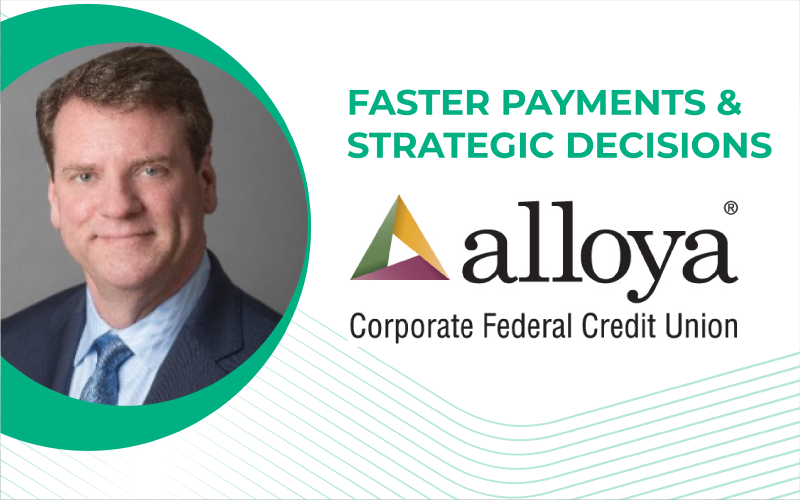Faster Payments: Strategic Decisions and the Member Experience
Posted by Katy Wagnon on May 16, 2023

In recent years, Alloya has dedicated significant resources to help credit unions prepare to offer faster payment solutions to their members – a process it calls “the faster payments journey,” said Jim Schneck, chief strategy and innovation officer at Alloya Corporate Federal Credit Union.
Here, Schneck summarizes the key strategic decisions to be made and considerations that credit unions embarking on a faster payments journey should keep in mind.
Building Blocks
To understand the decisions that must be made in a faster payments journey, a breakdown of the faster payments building blocks can be helpful. Alloya describes these building blocks as:
- Member Interfaces: Payment apps, home banking apps, home banking software, etc.
- Faster Payments Rails: Same Day ACH, Debit Card (Push), Real-Time Networks
- Rail Operators: Federal Reserve, Mastercard Send®, Visa Direct, FedNow℠, RTP®
Member Interface Decisions
Member interfaces provide a tangible user experience. Payments can be sent through mobile banking infrastructure and/or standalone payments apps. There are trends in two directions: some credit unions prefer to allow their members to send transactions within their mobile banking app, whereas other credit unions embrace their members’ preference for a standalone payments app.
When choosing an app for your faster payments member interface, considerations include:
- Accessibility (e.g., standalone app or integrated within a mobile banking app)
- Capabilities (e.g., Request-for-Pay, which extends beyond the simple need to send payment)
- Costs, including direct charges from the provider and sometimes additional network and interchange fees
- Use of an external account vs. directly using the credit union account
- Expected adoption rate
- Fraud mitigation
- Faster payment rail options
Faster Payments Rail Decisions
Next, consider which faster payments rails can be accessed through your chosen member interface.
- Same Day ACH: Quicker and more costly than traditional ACH and transactions require hours to process before the funds arrive to the recipient.
- Debit Card (Push): Takes up to 30 minutes for funds to arrive to the recipient (though recent experience shows an average of 18 seconds.) The relatively new MasterCard Send® and Visa Direct networks enable the user to send or “push” a payment to others when they sign up for the app using a debit card.
- Real-Time Networks: Funds arrive to the recipient within seconds.
Alloya views faster payments as an all-of-the-above approach, where each of these rails has unique attributes and deserves a place in the payments mix. It believes payments volume will increase overall with the real-time segment growing to approximately 15% of the payments mix in the U.S. over the next five years.
Real-Time Network Decisions
Recent industry attention has focused on real-time rails and their two operators: The Clearing House’s RTP® network, which launched in 2017, and the Federal Reserve’s FedNow℠ Service, to be launched in July 2023. These networks allow for more powerful use cases and better member experiences, driven by transaction posting and settlement that occurs within seconds. Of course, this significant advancement in payments requires unique strategic decisions and implementation challenges.
The first decision concerns whether to use one or both networks. FedNow℠ and RTP® will not interoperate. This means both parties of a transaction need to be connected to the same rail operator. When deciding between operators, keep in mind there is no right or wrong choice. Either or both are viable depending upon your member experience strategy. For a quicker impact, a near-term connection to RTP® is practical as its network has access to over 60% of U.S. demand deposit accounts (DDAs). In the future, FedNow℠ will likely be better positioned to achieve ubiquity.
The second decision concerns whether to implement “receive only” or “send and receive” capabilities. Both options are available with both real-time operators. “Receive only” is an easier implementation. “Send and receive” provides more robust use cases, but also presents a greater challenge due to additional capability requirements, such as liquidity management.
Real-time funds availability also introduces new technical requirements, such as posting to core processors in real time, and puts pressure on fraud prevention and recovery approaches, since payments are settled immediately.
You’re in Good Company
The journey to faster payments is a path best traveled in good company. Alloya has made it its mission to walk in step with credit unions like yours to help you explore these considerations and decisions in depth through our educational community, Alloya Insights: Faster Payments.
To learn more about this community and gain access to our detailed, proprietary Real-Time Payments Financial Model, contact your Alloya representative, visit the website or contact your GoWest Solutions Team.
Posted in GoWest Solutions, Top Headlines.





















